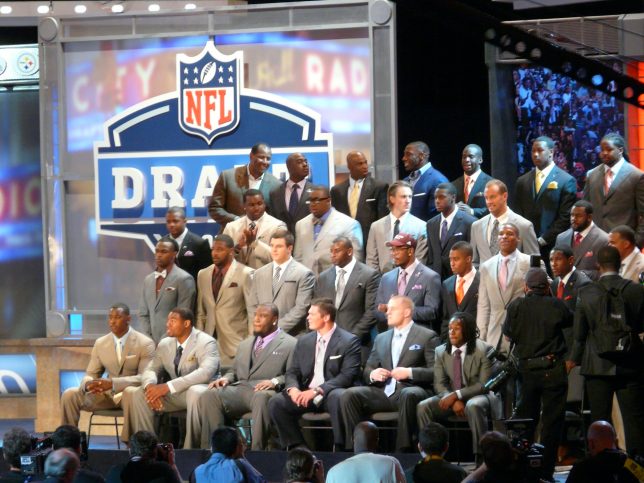Deception & Misdirection
Forget Graduation—For Division I Football Players the Draft Is the Finish Line


For most college seniors, the final weeks of May represent the culmination of years of hard work. They’ll don their caps and gowns with pride and participate in the final ceremony of their scholastic career—commencement. But for a smaller cohort of Division I football players, commencement is incidental. The NFL Draft is the raison d’etre for pursuing a college education.
Uniquely among the four major professional sports, the NFL does not have a minor league. Most athletes who dream of playing professional football simply cannot pursue their dream without going through the college ranks. The rules of the NFL prevent high school graduates from entering the draft for three years. Playing college football is the way to fill in intervening time between graduating high school and becoming draft eligible. In those three years, scouts are watching elite college squads, and players are being groomed for professional success. Many even earn a large fan following, and these Division I stars often dominate the NFL draft.
Football is the most expensive game to field in popular sports due to the size of a team, the facilities needed to play and train, and the insurance needed to cover injuries; this is true at both the collegiate and professional level. The NFL (a trade association that bowed to public opinion and gave up its nonprofit status in 2015) supports itself through television licensing and advertising. Colleges attempt to do the same, but as nonprofit or state institutions, they have other ways of funding themselves.
At the same time, football does generate the most revenue in college sports, but that doesn’t mean it generates enough revenue to cover expenses and turn a profit. Only a handful of teams are actually profitable. (Think Ohio State, Michigan, and Alabama.) Other universities turn to clever accounting practices. Mandatory student fees or “allocated revenue” siphoned from tuition or state grants to higher education count as athletic department “profits.” Many students and boosters love the atmosphere and community that stems from hosting ESPN’s College Game Day. But do students know that their federal student loans are subsidizing the NFL’s talent development?
Where Is the NFL’s Minor League?
Although players don’t typically make six figures in the minor league, they are able to make a living through their signing bonuses or their playing wages. AAA ballplayers don’t have to wait for some probationary period to try out. There’s a distinctly American and entrepreneurial air about minor league baseball: immigrant and American-born players pursue their big-league dreams while collecting cash pay and signing bonuses, rather than scholarships they may never see through to graduation. The NFL Draft rules privilege those who can afford to lose three years of potential wages.
And what about star college players who become household names? The colleges and the NCAA split the profit on merchandise sales. But players don’t see a dime; they are not allowed to see money generated by their image, likeness, or name.
So the NFL and its clubs don’t incur the cost of developing talent. The NCAA doesn’t pay the students who are the source of their revenue or risk incurring liability (since the players aren’t employees). The school gets scholarship money, publicity, and tax money through state appropriations and student loans. At least the athletes get a degree and the opportunity to play. Right?
Field of Broken Dreams
For every fairy tale that ends victoriously with college athletes going pro and bringing their teams to glory, there are less-savory fables of players who are injured, unlucky, or simply not talented enough to compete in professional sports. The hidden costs of academe’s compromise with athletic programs rest most heavily on these students. The NCAA estimates just 1.6 percent of its players will go on to play professional football. Even if they do graduate, these student athletes may have struggled with their classes or sustained head injuries. We can only hope their athletic-track education prepared them for careers off the field. But academic scandals in college sports put even the value of students’ degrees in doubt.
For 18 years, the University of North Carolina administered “paper courses”—primarily to football and basketball players. The easy “A’s” enabled many players to maintain their academic eligibility, even though the classes did not meet regularly and the final “papers” failed to meet the standards of a freshman writing class. And it’s not an isolated incident. In 2009, the Florida State Seminoles were found to have football players committing academic fraud. Teaching assistants and tutors were taking exams and writing papers for academically weak players. Educational institutions that go to such lengths are robbing their students of their education and cheating the other student athletes who put in the time and energy to succeed off the field.
Certainly, athletics can be an enriching part of a well-rounded education. But, when large public universities train the NFL’s next class of rookie players, these players’ schedules are decidedly unbalanced in favor of football. The practice of “red shirting” a player (essentially allowing a player to attend college for five years as they sit out a year of football to train) is a nod to the fact that these athletes aren’t in school for intellectual enrichment. That fifth year is a waste of resources for everyone except the NFL and its clubs, which will benefit from the player’s extra year of training.
There are also the players who enter the draft as college juniors. They’ve waited their requisite three years after graduating high school and want to try their luck early. It’s a gamble because if they engage an agent to help them negotiate potential contracts, they lose their eligibility to play NCAA football. Why risk losing a place on a good team before graduating? Many players are already at risk of losing eligibility due to academic requirements. Some players run out of classes they can pass, and so it’s worth trying to leave college early to capitalize on their college football career before it’s over.
The Bottom Line for Taxpayers
When policymakers and education advocates outline the reasons higher education should receive public funds, many wax poetic about civic virtue and the life of the mind. For example, from Alexander Meiklejohn: “Our scheme of government and of life can succeed only if . . . men and women will engage in careful, enthusiastic, and guided study of common values, common dangers, and common opportunities.” Before the rise of the college-athletic–industrial complex, collegiate sports easily fit into this vision for education.
But, Providing the NFL with de facto farm leagues isn’t meant to be a part of flagship universities’ missions. It certainly doesn’t merit the use of taxpayer funds. And the scandals that emerge every year in high-revenue sports serve as reminders that many are willing to win at any cost—whether it’s accepting students who aren’t capable of college-level work, helping students game the academic system to maintain eligibility, or sweeping criminal behavior under the rug. But as long as the NCAA and colleges can profit from taxpayer money and the NFL can use Division I football to defray the costs of recruiting players, this boondoggle will continue.



